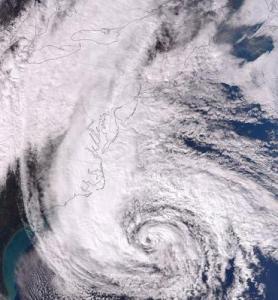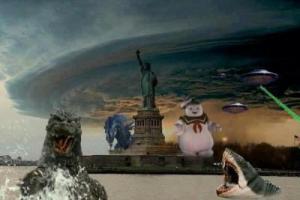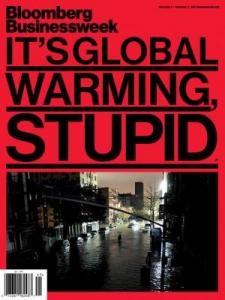On science blogs this week: The Climate
HURRICANE SANDY AND THE SCIENCE OF WEATHER. Not to dismiss the tsunami of bad news, which now includes more than 100 deaths, but Matt Daniel at Earth/Sky points out the good news: the storm was a triumph for weather science. The forecast for Sandy, he says, could be considered one of meteorology's finest moments.
The European Centre for Medium-Range Weather Forecasts accurately predicted that it would affect millions in New England more than a week in advance. Not so for the American Global Forecast System, which is less well funded; at that time, it was saying the storm would push out to sea. Then NOAA launched weather balloons. Along with satellite data, they helped define the storm's track more accurately. Daniel embeds useful videos of the tracking.
A looming calamity, Daniel says, is increasingly bad forecasting due to our dwindling number of weather satellites. There are 23 right now, but the number will be down to 6 by 2020. Satellite building and launching has been delayed, budgets have been cut, launches have failed...
If we do not improve these problems, then all of the progress we have made in the study of atmospheric sciences will be for nothing. Now, do you see how important it is to fund and receive full support for NOAA/NASA?
He also describes plenty of bad news. People didn't take the warnings seriously, partly because last year's hurricane Irene had turned out to be not nearly so bad as predicted. Hurricane watches and warnings were not issued along the New Jersey and New York coasts because Sandy lost official hurricane status as it moved inland.
Also, social media were larded with fake messages and hoax photos; Daniel reproduces some of these. Twitter's de facto status as the most immediate source of breaking news is often deserved, but not always — and it's not always easy to tell the real from the bogus. Most of the time. The NYTimes had a piece about this too.
HURRICANE SANDY AND GLOBAL WARMING. David Middleton's guest post at the denialist blog Watts Up With That pooh-poohs Sandy's storm surge in New England, arguing that it was much worse in the hurricanes of 1635 and 1638. Also, not so coincidentally, that the 17th century was the coldest in the last 2000 years. Take that, Al Gore.
Which nicely illustrates the trouble with attributing over-the-top storms like Sandy to global warming. At Quark Soup, David Appell points out that you then have to explain why earlier over-the-top storms happened.
So you have to use statistical trends. And I don't see that they're there — not for global hurricane frequency, or global accumulated cyclone energy (ACE), or global power dissipation index. Restricting one's view to the North Atlantic does show a trend, especially in ACE and tropical storms and major hurricanes. But then you have to explain why it's happening in the North Atlantic but not elsewhere on the globe, and why it's not natural.
So establishing that a particular storm was worsened by climate change, he says, is not currently possible. Nor even, Appell argues, all that important, because the most significant effects of climate change will be on water supply and drought and agriculture — all of which will spread far more devastation than a single storm, however dreadful.
Yes, meteorologist Dan Satterfield says at the AGU Blogosphere, Sandy-like storms could occur even if carbon dioxide and Arctic sea ice were at stable levels. But it is possible to extrapolate from what is known about our real world of ocean warming and wetter atmosphere and higher sea levels. And the extrapolation isn't pretty:
If a storm exactly like Sandy were to have hit in October of 1912, it would have been less wet with a storm surge that was lower. We can also say that a storm exactly like Sandy 90 years from now will be much wetter with water levels at least 24 inches higher.
OTOH, in a post at Dot Earth that's full of useful links, Andy Revkin makes the crucial point: there may be no way to establish that Sandy was worse because Homo sap made it so, but there is no question our species is responsible for the extent of devastation.
In 1635 and 1638, huge storm surges probably remodeled the coastline and devastated animal and plant life, but there were few people around and hardly any human infrastructure to be destroyed. There were no wooden houses along every coast and riverbank, no seaside roller coasters and miniature golf courses, no floodable subway system or underwater tunnels from Brooklyn to the Battery or anywhere else, no electricity that could vanish and leave millions powerless without light and heat and communication and drinkable water, no industrial food supply that depended on open highways and functioning supermarkets to feed the hungry millions.
There are lots of photos at the Atlantic In Focus. See in particular #3, sea water pouring into the Ground Zero site, #8, photographing surf on Beach Avenue in Cape May, NJ, #10, water pouring into an underground parking garage — why the devil didn't people move their cars?, #26, the financial district in the dark; #34, keep off in Cape May; #41, a dazzling composition of flooded yellow cabs in Hoboken. Many photos, and links to others, at Grist, too.
HURRICANE SANDY MISCELLANY. Millions of posts re: Sandy at the HuffPo blogs; see for yourself
A little-talked about Sandy tragedy: Thousands of genetically engineered lab rodents drowned in basement labs at New York University. At Well, Benedict Carey describes the impacts on research and researchers.
Anthropologist Adonia Lugo's post at Savage Minds is about bicycling as a way of hacking urban space and as a tool for ethnographic studies, but she has embedded an extraordinary video of bicycling through New York City during Monday night's flooding.
Birders may be the only ethnographic group who see Sandy as an opportunity — an opportunity to find unusual birds blown to strange territories. John Puschock is keeping track and collecting field reports from birders at the American Birding Association blog. At 10,000 Birds, Corey described his wet, cold, frustrating day of birdseeking in Queens, Brooklyn, and Jamaica Bay. But finally, reward: an American Avocet, normally a citizen of the Midwest and Pacific Coast. Plus Green-winged Teal, Forster's Terns, and Yellowlegs, both Greater and Lesser.
HURRICANE SANDY AND PRESIDENTIAL POLITICS AND SCIENCE. Sandy seems to have done the unthinkable in another way: it has injected climate change into the presidential election at last. It may never be possible to establish for sure that Sandy's violence was heightened by global warming, but it undoubtedly provides a teachable moment. New York's Mayor Michael Bloomberg appears to believe it enough to endorse President Obama in next Tuesday's Presidential election because he thinks Obama offers the best chance of taking action against climate change.
At Wonkblog, Brad Plumer considers whether Obama deserves that leap of faith and concludes that the President's incremental approach is not enough, but he's mostly done what he could in the face of intransigent Republicans.
So one way to read Bloomberg’s endorsement is that he’s trying to shift the politics of climate change to make big action more possible for a president who would like to take big action. And, right now, Obama has said he’ll cooperate with that strategy, while Romney has said he won’t.
So what will the election mean for US science? That question was considered in a live chat yesterday afternoon (Thursday) that Science reporter David Malakoff had with Thomas J. Bollyky of the Council on Foreign Relations and Michael S. Lubell of the American Physical Society. I haven't had a chance to read it yet, but find the transcript at the link.
THE POLITICS OF HEALTH CARE. At the Health Care Blog, Dan Diamond would like to tell you about how US health care changed while you were watching the election. He says the most significant recent health care changes haven’t originated in politics but in the private sector. Employers and providers have made aggressive and sometimes surprising decisions. These seem likely to shift some costs to employees and also limit the pool of providers they can use — changes that will happen no matter who is President and what happens to Obamacare.
At JAMA Viewpoint, two lawyers conclude that, even if Romney wins, outright repeal of Obamacare is unlikely. But many of its provisions could be blocked or altered, including the individual mandate, the requirement that everybody buy health insurance. At JAMA Forum, docs Michael Zinner and Edward Livingston describe Romneycare, the Massachusetts precursor of Obamacare, but they're a bit anxious over the fact that Obamacare will be implemented much faster. They conclude
The lesson from Massachusetts is that improved health care delivery can be achieved when there is broad-based community support, when reform elements are implemented in a reasonably confined population, and when change is introduced slowly enough to allow market forces to adapt to the new environment.
THE SCIENCE OF POLITICS AND THE NATE SILVER BACKLASH. I read Nate Silver's poll analysis blog FiveThirtyEight compulsively every day at the New York Times, and I'm not the only one. Silver is a former baseball statistician of the sort enshrined in the movie Moneyball, a "quant," meaning that he lives for data and does the math.
Silver has generated what journalists love to call a firestorm, not least because his math has consistently showed Obama slightly ahead, especially in the so-called swing states that will decide the election. As I write, Silver's model, which aggregates state polls, shows that Obama has about an 80% chance of winning election. Which means, of course, that Romney's chance is about 20%. But people keep forgetting that.
Ezra Klein described the backlash against Silver at Wonkblog and analyzed the critiques. Some are simply political, some are weird, and some are just clueless about the nature of probability. i.e., there's strong opposition to bringing science into politics.
Klein observes that one reason for the backlash is because Silver is an affront to traditional horse-race political journalism and its attendant punditry. I am tempted to quote several grafs because they are terrific, but you should really read the post yourself. The point is that political writers have a stake in the race always being up for grabs because that's what inveigles the audience into coming back. Tell them for months that Obama's a bit ahead and is likely to win, and you'll drive them into the arms of novelists, for God's sake.
At Nieman Labs, Jonathan Stray also thinks Nate Silver's work is a lesson for political journalists; they need to get over their fear of data and stop pretending that their own publication's polls are the gold standard. Stray notes that it was think tanks, not journalists, who did the math on the Romney-Ryan budget numbers and showed that they didn't add up.
He argues that journalism needs more specialization. I guess that could mean a bright future and good news for science writers. But one implication is that even with specialists like us, some of us may not be specialized enough.
At The Atlantic, James Fallows has a chilling analysis of why Republican apparatchiks and right-leaning Web sites keep insisting that Romney is way ahead and absolutely bound to win, despite the lower probability Silver and most of the pollsters discern from their data. Fallows suggests that this may be a deliberate strategy by professional Republicans who know perfectly well that the numbers are against them. They are hoping that if Obama wins, the many folks who have bought in to the alternate reality in which Romney is the inevitable winner will be convinced that the election is fraudulent. Which will feed the persistent fantasy that the Obama presidency is illegitimate. Which will suit the Republican pros just fine.
HURRICANE SANDY HAS NOTHING TO DO WITH THE FACT THAT THE JONAH LEHRER TALE IS BACK AGAIN. Faye Flam at the Knight Science Journalism Tracker mostly likes a New York Magazine piece about the fall of science journalist Jonah Lehrer, discussed often here (not to mention elsewhere). The piece has this marvelous hed, a play on the title of one of Lehrer's books: Proust Wasn't a Neuroscientist and Neither is Jonah Lehrer. Writer Boris Kachka argues that Lehrer didn't just make up quotes, he made up startling ideas about how the human brain works and then invented facts to support them.
Flam quotes at length from Kachka's discussion of the flimsiness of Lehrer's New Yorker piece about why scientific findings often cannot be replicated. The piece generated considerable heat among science writers and science journalists, notably SciAm's John Horgan.




